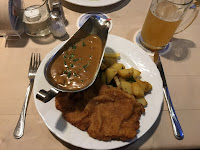I recently
visited again my favorite Wirtshaus in Frankfurt together with my family. A
Wirtshaus is a traditional German inn which typically services classic German
dishes like Schnitzel and pork knuckle, and of course serves beer with it. This
one, the Ginnheimer Wirtshaus, as is often the case, also has an adjacent
beer-garden. I got to know this spot because my first apartment in Frankfurt
was situated close by. The area is already what is considered the outer suburbs
of Frankfurt, off the city center and away from the super lively and popular
inner suburbs. Therefore, this place is really a local experience. However, it
is by no means a secret hidden place. It is located just outside the Nidda Park
and is getting really busy on nice summer weekends, when hikers, cyclists and
locals stop to have a meal and a beer or two.
I visited the
Ginnheimer Wirtshaus already multiple times and absolutely love it there. In
case of good weather, one typically sits outside in the beer-garden (if you
manage to get a place). However, I have also visited many times sitting inside
and it feels very homey and comfortable. The place has a traditional rustic
charm and the service is super friendly. Therefore, in a cold winter day it is
equally nice to visit and I like the feeling of sitting in the warmth, eating a
heavy meal and enjoying the cozy atmosphere.
Another
reason why I love this place, is that the food as actually really good.
Obviously, the dishes are proper down-to-earth German style. The highlight is
their Grüne Soße (green sauce), the typical Frankfurter sauce made of different
herbs and cream. Ginnheimer Wirtshaus has, in my opinion, one of the best Grüne
Soße in Frankfurt – sorry to all Sachsenhauseners who usually claim this title.
The sauce needs to be really fresh tasting and it totally does at Ginnheimer
Wirtshaus. It is therefore a great place to bring friends and family to show
some traditional Frankfurt dish.
When we
visited recently, the autumn season already started and the days were getting
shorter. So, we went inside and got a cozy table. Obviously, my parents had to
order a dish of Grüne Soße. They chose a classic Frankfurt one that has eggs
and potatoes. I went for the so-called Frankfurter Schnitzel, which I think is
also must-try for all visitors of the city. It is the usual Schnitzel, but
covered by a thick layer of fresh Grüne Soße. Needless to say, that I loved my
Schnitzel in Ginheimer Wirtshaus. My parents were equally enthusiastic about
their dish. And my wife had a Schnitzel with a mushroom sauce (champignons),
which is also really good there. Overall, this is a great stop for anyone
visiting the Nidda Park and looking for a traditional Frankfurt dining and
drinking experience.
Style: Casual
eatery/Dinner
Cuisine: German
Location: Ginnheim
Website: http://www.ginnheimer-wirtshaus.de/








